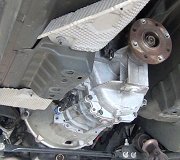Yippee! One in a row! Happy to hear it's solved.
You're right about the relearn procedure. If you had the Chrysler DRB3 scanner, there is a relearn sequence that can be done in the shop, but few mechanics use that because it's easy to do the normal way. After any transmission work, the vehicle gets a test-drive, and that's enough miles for the relearn to take place.
There are four clutch packs with steel and fiber plates that wear out over time just like in all transmissions. The difference is with the old ones, slipping between shifts gradually increased as those fiber plates wore out, and you'd have two or three years notice that was taking place. The shifts were just a little more mushy as the months went by. Chrysler was the first to use this design where the computer watches how many CCs of fluid it takes to apply each clutch pack. As the plates wear down and get thinner, it takes more and more fluid to fully apply the packs. It takes time to fill those assemblies with fluid, so to maintain the nice crisp shift quality, the computer learns to apply third gear, for example, just a fuzz sooner before releasing second gear. That gives third gear time to get fully locked up just as second gear is releasing.
Depending on the amount of wear in the clutch packs, before the relearn takes place, the transmission could feel like a dragster with a real hard shift quality, or it could be real soft and mushy. It takes about a dozen up-shifts over a few miles to complete the relearn process. Most people don't even know that's taking place. The Transmission Computer goes through the same relearn procedure after simply disconnecting the battery, at least that was the case in the '90s. Most newer computers retain much of their learning and programming when the battery is disconnected.
If you're interested, the DRB3 scanner will display the "clutch volume index", (CVI) to show how much life is left in the clutch packs. The updating of the shift schedules as you drive is what makes the shifts feel like when the vehicle was brand new, but since you can't go by feel anymore to get an idea of the wear, this set of four numbers shows the volume, in cubic centimeters, of fluid it takes to apply each clutch pack. An experienced transmission specialist can tell by those number how much life is left in the transmission. A lot of independent shops have the Chrysler DRB3 scanner because with an extra plug-in card, they could do emissions-related diagnostics on any brand of vehicle sold in the U.S. Starting with '96 models. I suspect a lot of the better aftermarket scanners have this capability too.
The big disadvantage to this computer-controlled system is the shift feel is always nice and solid, ... As long as the computer can keep updating when to apply and release each clutch pack. The time will come when it can't update any further because the plates are so worn, there is no amount of fluid that will make that clutch pack lock up solidly. You would never get that far with the older transmissions because the severe amount of slippage would be horrendously annoying. That slippage would cause a lot of excess heat to be generated which would damage a lot of other components. Once this computer can't update further, slippage occurs, that is detected by the computer, it sets a diagnostic fault code related to "gear ratio error", and defaults to "limp mode" which gives you second gear, neutral, reverse, and park. The problem is you go from shifting fine yesterday to limp mode today with no warning. You can get an extra couple of years out of the transmission, but try selling that as an advantage to the family in the middle of a cross-country vacation!
Monday, October 26th, 2015 AT 9:31 PM


